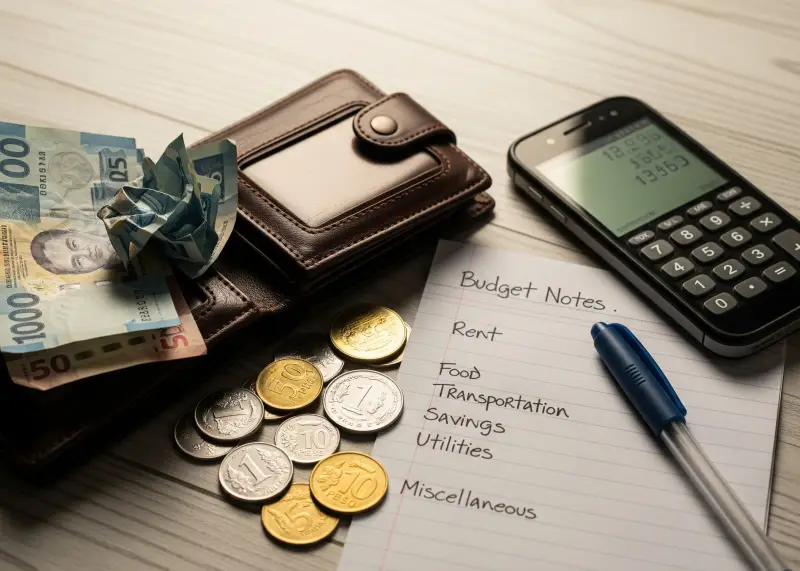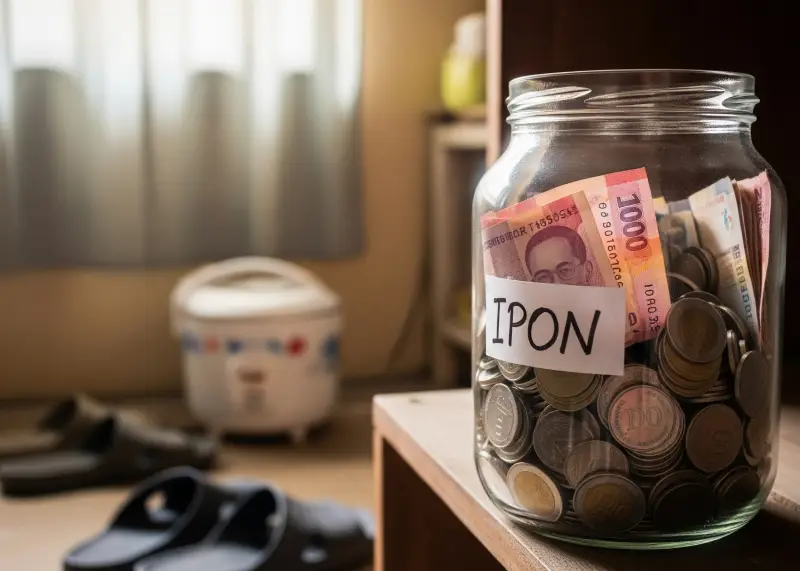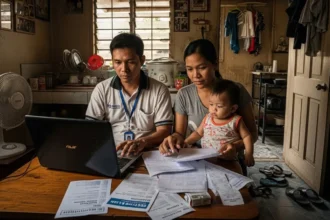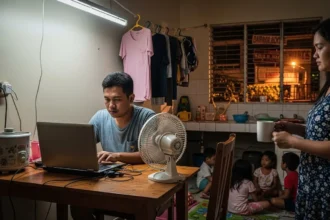Living in the Philippines on a ₱20,000 monthly salary can feel like walking a tightrope. Minsan, kulang na kulang talaga-rent, food, bills, pamasahe, at kung minsan may extra pa na gastusin for family. But here’s the thing: a ₱20K salary is workable, if we become intentional about how we budget.
- 💡 Why Budgeting ₱20K Really Matters
- 🏠 Breaking Down the Budget: Needs vs. Wants
- 🍚 Food and Grocery Hacks That Stretch Your Salary
- 🚍 Getting Around Without Burning Your Wallet
- 💡 Small Money Habits That Add Up
- 💸 How to Save Even on ₱20K Salary
- 📊 A Day-to-Day Budget Sample for a ₱20K Salary
- 🙋♂️ FAQs About Budgeting a ₱20K Salary in the Philippines
- 🌱 My Heartfelt Advice to Fellow 20K Earners
I’ve been there myself, wondering how to make ends meet. And through trial and error, I’ve learned ways to stretch that ₱20K without feeling like you’re depriving yourself. So in this article, let’s go deep into practical tips, sample allocations, and relatable hacks you can apply right away.
💡 Why Budgeting ₱20K Really Matters
When you only have ₱20,000 coming in every month, every peso counts. Without a clear budget, madaling mawala ang pera sa maliliit na gastusin-Grab rides here, milk tea there, online shopping during sales. Before you know it, ubos na ang sweldo kahit kalahating buwan pa lang.
Budgeting is not about being kuripot; it’s about giving yourself peace of mind. If you know exactly where your money goes, you avoid stress and guilt. More importantly, budgeting helps you:
-
Save for emergencies (kasi laging may unexpected gastos)
-
Enjoy small luxuries without breaking the bank
-
Support family when needed without sacrificing your own financial health
-
Start building your future kahit maliit pa ang income
At the end of the day, budgeting with ₱20K is about control-you control the money, instead of money controlling you.

🏠 Breaking Down the Budget: Needs vs. Wants
The first step is understanding the difference between needs and wants. Needs are essentials-housing, food, utilities, transportation. Wants are the nice-to-haves like eating out, subscriptions, and shopping.
For a ₱20K salary, a realistic breakdown could look like this:
| Expense Category | Suggested Percentage | Example Amount |
|---|---|---|
| Needs | 50% | ₱10,000 |
| Wants | 30% | ₱6,000 |
| Savings / Investments | 20% | ₱4,000 |
This rule isn’t set in stone. If your rent is high, you’ll need to adjust by trimming “wants.” Kung mas maliit ang renta, that’s extra money for savings or leisure. What matters most is having a clear plan that fits your lifestyle and priorities.
🍚 Food and Grocery Hacks That Stretch Your Salary
Food is one of the biggest budget eaters, but it’s also the easiest to adjust. Alam natin lahat: eating out in Manila can drain your wallet fast. A single fast food meal can cost ₱150–₱200. Do that 10 times a week, and that’s already ₱6,000 gone.
Instead, try these:
-
Cook at home: A week’s worth of ulam bought from the palengke often costs less than two fast food meals.
-
Plan your meals: When you plan ahead, mas konti ang sayang sa pagkain.
-
Buy in bulk: Rice, canned goods, and frozen meats are cheaper when bought in larger packs.
-
Try “baon” culture: Bringing packed lunch to work saves a ton and is usually healthier.
-
Limit milk tea/coffee runs: Treat them as rewards, not daily habits.
By cooking more and limiting take-out, you can save ₱2,000–₱3,000 a month, money you can redirect to savings or other goals.
🚍 Getting Around Without Burning Your Wallet
Transportation in the Philippines can be unpredictable. A ₱20K earner can’t always afford daily Grab rides. A realistic monthly transportation budget ranges from ₱2,000–₱3,000 depending on your commute.
Some practical hacks:
-
Use public transport when possible (MRT, jeepneys, buses).
-
Carpool with officemates to save money and reduce travel stress.
-
Get a Beep card and load it weekly to control spending.
-
If you live near work, walk or bike – exercise pa!
Transportation is one of those expenses you can’t avoid, but with discipline, you can keep it manageable.
💡 Small Money Habits That Add Up
Budgeting isn’t just about cutting costs; it’s really about developing small daily habits that protect your money and help you live smarter. In fact, these little adjustments may not seem like much at first, pero kapag consistent ka, they build up into huge savings over time. The goal is not to deprive yourself, but to create a system where your money works for you instead of disappearing unnoticed.
One practical method is using cash envelopes. Label them as “Food,” “Bills,” or “Savings,” then withdraw the exact budget for each. Kapag naubos na yung laman, that’s it-wala nang dagdag. It forces you to be mindful and keeps you from overspending.
Another helpful step is to track your expenses. You don’t need fancy tools-free apps like Money Manager or even a simple Google Sheet will do. The point is to actually see where your money goes, kasi minsan di natin napapansin na malaki na pala napupunta sa milk tea or delivery fees.
Don’t forget to cancel unused subscriptions like Netflix, Spotify, or paid apps you barely use. It sounds small, but ₱200–₱500 monthly adds up to thousands in a year. Sayang!
If your company offers employee benefits like HMO, transportation allowance, or free meals, make sure to maximize them. These benefits are there to lighten your load-using them wisely can save you thousands every month.
Finally, watch out for lifestyle inflation. Just because you got a raise doesn’t mean you should upgrade your phone, buy branded clothes, or eat out more often. Stay grounded and direct that extra income to savings or investments instead.
These small money habits may feel simple, but they’re powerful. They help you stay in control of your spending while still enjoying life in moderation. Over time, these tiny changes become the foundation of financial security.

💸 How to Save Even on ₱20K Salary
You might be thinking, “Paano ako makakapag-ipon kung sakto lang ang ₱20K sweldo ko?” The truth is, saving is possible even on a tight budget – but it requires discipline, consistency, and a shift in mindset. The golden rule is simple: pay yourself first. The moment sweldo comes in, set aside a fixed amount for savings – even just ₱2,000 to ₱3,000 – before you pay bills or spend on wants. Treat it like a non-negotiable expense.
Practical Ways to Save Smart
-
Emergency Fund First – Aim to build at least 3–6 months’ worth of expenses. Start small: even ₱500 per payday adds up. Having this fund protects you from relying on utang during emergencies.
-
Pag-IBIG MP2 – This government-backed savings program lets you grow your money faster than a regular savings account. Minimum is only ₱500, and returns are higher than most banks.
-
High-Interest Digital Banks – Apps like GCash GSave, Maya Bank, or Tonik offer up to 4–6% annual interest – way better than traditional banks. They also make saving easy since you can auto-transfer a portion of your sweldo.
-
Side Hustles for Extra Income – With ₱20K, your budget may feel tight, so adding a small sideline can help. Try freelancing online, reselling items on Facebook Marketplace, tutoring, or even small e-load or food side businesses.
Consistency is the Secret
Even if you can only set aside ₱500 per cutoff, that’s ₱12,000 in just one year. Over time, these small, steady contributions become a safety net – one that gives peace of mind and financial breathing room. The key is to start now, no matter how small, and never skip.
At the end of the day, it’s not the amount that builds wealth – it’s the habit of saving.
📊 A Day-to-Day Budget Sample for a ₱20K Salary
It’s one thing to see percentages and allocations, but sometimes it helps to look at an actual daily budget. After all, sweldo in the Philippines often feels like it disappears one day at a time. By breaking down expenses into daily limits, you’ll see how manageable ₱20K can actually be with the right discipline.
Here’s a sample breakdown for someone earning ₱20,000 monthly, living modestly in Metro Manila:
Table 2: Day-to-Day Budget Sample (₱20,000 Salary)
| Expense Category | Monthly Allocation | Daily Equivalent | Notes / Examples |
|---|---|---|---|
| Rent / Housing | ₱6,000 | ₱200/day | Shared apartment or modest studio |
| Food & Groceries | ₱4,500 | ₱150/day | Home-cooked meals + market shopping |
| Transportation | ₱2,500 | ₱80/day | MRT, jeepney, bus rides |
| Utilities & Bills | ₱1,500 | ₱50/day | Electricity, water, mobile load |
| Wants & Leisure | ₱3,500 | ₱115/day | Occasional dining out, movies, shopping |
| Savings / Investments | ₱2,000 | ₱65/day | Emergency fund, Pag-IBIG MP2, digital bank savings |
| Total | ₱20,000 | ₱660/day | Balanced daily living within ₱20K |
📝 How to Use This Daily Budget
When you think of your salary in terms of daily spending limits, it becomes easier to say “no” to unnecessary gastos. For example, if your daily allowance is around ₱660 (based on the table), then spending ₱250 on a single milk tea run and snacks suddenly feels heavier because that’s almost half your food budget for the day.
Instead, you can reframe your habits: cook baon for work (₱50–₱80 per meal), use public transport, and save the “wants” budget for weekends or special occasions. This way, you don’t feel deprived but you’re still living within your means.
Breaking the salary into daily chunks makes it more tangible and gives you control. It’s easier to monitor “Did I stay within ₱600–₱700 today?” than to track vague monthly numbers. Over time, these small daily wins add up to big financial progress.
🙋♂️ FAQs About Budgeting a ₱20K Salary in the Philippines
1. Is ₱20K enough to live on in Metro Manila?
It’s tough but doable with strict budgeting. Sharing rent or living with family helps a lot.
2. How much should I save each month?
Aim for 10–20% of your income, or ₱2,000–₱4,000 monthly.
3. Can I still invest with a ₱20K salary?
Yes, start small with Pag-IBIG MP2, UITFs, or mutual funds.
4. How do I manage family support on a ₱20K income?
Be honest about what you can afford. Prioritize essentials, then set aside a fixed family allowance.
5. Should I get a credit card on a ₱20K salary?
Yes, but only if you can pay in full monthly. Use it to build credit, not as extra cash.
6. How do I avoid overspending on wants?
Set a fixed “fun budget.” Once it’s gone, no more spending until the next payday.
7. Is it possible to save for travel with ₱20K?
Yes, if you plan ahead and book promo fares. Start a small travel fund.
8. Should I live alone with this salary?
If you’re in Manila, it’s better to share rent or stay with family to save more.
9. How do I handle debt with this budget?
Prioritize paying high-interest debt first, while still setting aside small savings.
10. What’s the best budgeting method for ₱20K?
The 50/30/20 rule works, but you can tweak it based on your lifestyle.
🌱 My Heartfelt Advice to Fellow 20K Earners
If you’re living on ₱20K, I get you. Totoo, mahirap at minsan nakaka-frustrate. But remember this: your salary does not define your future. Budgeting is just a stepping stone. What matters most is building good habits now, so when your income grows, you won’t fall into the trap of lifestyle inflation.
Every peso you save is a peso closer to freedom. Kahit maliit, basta tuloy-tuloy, lalaki rin yan. And one day, you’ll look back and thank yourself for starting early.
So don’t lose hope. With discipline, intentional choices, and a bit of creativity, you can thrive even on a ₱20K salary.













